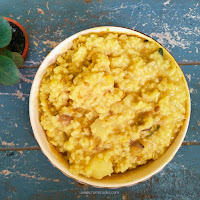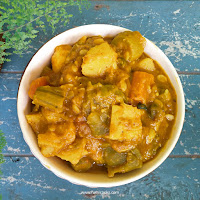Portion Control Meal Plate :No Onion No Garlic Dal Khichuri, Labra Sabzi, Roasted Papad, Pickle, Wheat Phulka (luci) and Curd
I prepared no onion no garlic dal khichuri and labra sabzi on the occasion of Biswakarma puja at home last week. Together with khichuri and labra, I also served roasted papad, pickles, luci (Indian flattened bread) and curd.
Every person's calorie intake is individual based on their personal goals and needs. But according to nutrition experts a fully grown person's daily consumption at each lunch or dinner should be within 500 to 700 calories.
Here is the calorie list of today's meal plan:
- 1 bowl of dal khichuri = 320 cal
- 1 bowl of mix veggies =65 cal
- 1 roasted papad=29 cal
- 2 luci =70x2=140 cal
- 1 bowl (50 gms) curd =50 cal
- Pickle(1/2 tbsp) = 49 cal
- Total = 653 cal
Khichuri is a very popular versatile dish of Indian cuisine. Made of rice and lentil, khichuri has many variations. Khichuri actually is a kind of salty porridge that is served to babies as one of the first solid foods. It is also served to sick persons who is unable to eat hard solid food. In Assamese it is called Khichiri (খিচিৰি).
Khichuri is considered as one of the purest food in Hindu religion and therefore it is served on pujas. But the khichuri that is served on puja are called niramish (vegetarian) khichuri where use of onion and garlic are not allowed. On Saraswati puja khichuri is prepared and served in government schools and collages of Assam among the students. On Biswakarma puja khichuri is prepared and served in few offices and factories.
Khichuri is an important part of Druga puja and Kali puja festivals. Niramish khichuri is served among the devotees in Durga puja and Kali puja pandals as a Prasad.
Serving labra sabzi with khichuri is optional. Pickle can also be served with khichuri. Below is the recipe of no onion no garlic khichuri and labra sabzi that you can try at home.
Click for 'How to make roasted Papad roll'
Dal Khichuri Recipe Without Onion and Garlic
I made plain dal khichuri and have not added any vegetables. But if you want to add vegetables you can check the recipe here - "Khichuri : One pot meal".
📎Course : Main Course
📎Cuisine : Indian
🔪Preparation Time : 15 minutes
♨Cooking Time : 20 minutes
🕞Total : 35 minutes
🍴Servings : 3-4
INGREDIENTS:
- 1 cup rice (any)
- 1cup split moong dal
- 1/3 cup split chickpeas
- 1/4 cup nuts
- 1 bay leaf
- 2 whole dry red chilli
- 1/2 tsp Panch phoron
- 1 tsp turmeric powder
- 1/2 tsp cumin powder
- 1/2 tsp coriander powder
- 1 tsp red chilli powder
- 2 tbsp mustard oil
- 1 tbsp ghee (clarified butter)
- salt to taste
- 2 tbsp finely chopped coriander leaves
METHOD:
- Take rice in a pressure cooker pot. Rinse it with water. Drain and keep aside.
- Dry roast moong dal in a heated pan until fragrant . Rinse under running water. Drain and pour it with the rice in the pressure cooker pot.
- Rinse split chickpeas and nuts together under running water. Add into the pressure cooker.
- Add enough water to soak all the ingredients completely.
- Add salt and turmeric powder.
- Close the cooker and in high heat cook for 2-3 whistles or more if required .
- Remove cooker from heat and let it open itself.
- Now in a pan heat oil. Add whole dry red chilli, bay leaf and panch phoron.
- When crackling pour everything from the cooker.
- Add cumin powder, coriander powder and red chilli powder.
- Mix well. Cook for 5 minutes. Remove from heat.
- Add ghee and chopped coriander leaves.
- Now the khichuri is ready to serve.
Notes:
- Keep a cup of hot water ready. If you see the khichuri is too dry, then add some water and mix it well.
- Check the salt before serving. Add more salt if required and mix it well.
- Serve hot.
Labra (Mix Vegetable) Sabzi:
📎Course : Main Course
📎Cuisine : Indian
🔪Preparation Time : 30 minutes
♨Cooking Time : 35 minutes
🕞Total : 65 minutes
🍴Servings : 3-4
INGREDIENTS:
- 1 cup eggplant / brinjal, cut into pieces
- 1 cup pumpkin, peeled and cut into pieces
- 1/2 cup reddish, peeled and cut into pieces
- 1 cup potato, peeled and cut into pieces
- 1 cup taro root, peeled and cut into pieces
- 1 cup sponge gourd, peeled and sliced
- 1 cup bottle gourd, peeled and cut into pieces
- 1 teasel gourd, peeled and diced
- 7-8 jackfruit seeds, peeked
- 1/2 cup carrot, peeled and diced
- 1 cup cabbage, chopped
- 1 pointed gourd, peeled and sliced
- 8-10 curry leaves
- 1 bay leaf
- 2 whole dry red chilli
- 1/2 tsp Panch phoron
- 1 tsp turmeric powder
- 1/2 tsp cumin powder
- 1/2 tsp coriander powder
- 1 tsp red chilli powder
- 3-4 tbsp mustard oil
- salt to taste
- Finely chopped coriander leaves for garnishing
METHOD:
- Wash vegetables under running water. In a large bowl collect pieces of potato, pumpkin, bottle gourd, jackfruit seeds, taro root, teasel gourd, pointed gourd, carrot and reddish. In another bowl take eggplant and sponge gourd. Keep chopped cabbage in another bowl.
- In a pan heat oil. Add bay leaf, dry red chilies and panch phoron. When crackling add turmeric powder.
- Add vegetables which takes more time for cooking like potato, pumpkin, bottle gourd, jackfruit seeds, taro root, teasel gourd, pointed gourd, carrot and reddish. In medium heat cook for sometimes by covering the pan.
- Add chopped cabbage and curry leaves. Mix and cook for sometimes by covering the pan.
- Add cumin powder, coriander powder, chilli powder and salt. Mix well and again cook for sometimes by covering the pan.
- When these vegetables become half cooked, add pieces of sponge gourd and brinjal. Again cook for sometimes by covering the pan.
- Add 1 cup of water. (add more if required)
- Bring to boil and cook until all the vegetables become soft and cook well.
- Add chopped coriander leaves.
- Remove from heat. Labra sabzi is ready to serve now.
Notes :
- Add any vegetables of your choice but pumpkin is must.
- Add raddish and taro root as a must ingredient if available.
- Let the pumpkin pieces melt while cooking.




Comments
Post a Comment